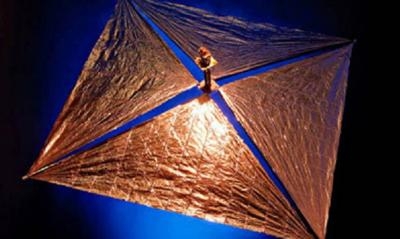Thu, Dec 26, 2013
New Method For Deorbiting Satellites Near First Test Flight
When satellites reach the end of their working lives, they may pose a threat to other spacecraft as they continue to orbit in a dormant state for many decades. But now a new way to deorbit aging satellites in a safe manner is nearing its first test in space. In the future, satellites might carry a packaged ultra-lightweight ‘gossamer sail’ to open as they head towards retirement. The increased aerodynamic drag would pull the craft out of orbit to burn up in the high atmosphere, reducing the risk of catastrophic collisions and creating a sustainable space environment for future generations.

At launch, the Gossamer Deorbit Sail is extremely compact, occupying 15x15x25 cm and weighing only 2 kg. It would expand in minutes to 5x5 m – enough to bring down a satellite of up to 700 kg. A frame of extremely lightweight carbon-fiber booms supports a sail of aluminized Kapton only a few thousandths of a millimeter thick – a fraction of the diameter of human hair.
The sail was developed at the University of Surrey’s Space Centre, funded through ESA’s Advanced Research in Telecommunications Systems program. It is primarily intended for satellites in low orbits, some 700 km up, such as those belonging to Iridium, Orbcomm and Globalstar, who provide satellite phone, low-speed data communications and messaging services. Under the European Code of Conduct for Space Debris Mitigation, created in 2008, ESA is committed to freeing up orbits within 25 years. However, a dormant satellite in 750km altitude without such a sail could remain in orbit for a century or even longer like a speeding bullet endangering new satellites.
In low orbits, there is still sufficient atmosphere to generate the needed drag thanks to the large sail size. Even with the sail, it could take up to 25 years for the satellite to reenter and disintegrate, but to deorbit in the same time frame using traditional thrusters would require ten times the equivalent mass in propellant. For satellites in higher orbits beyond the atmosphere, the sail could potentially use solar radiation pressure to descend with the help of an attitude control system – ‘solar sailing’.
The gossamer sail has been subjected to rigorous testing, including thermal, vibration and vacuum tests. The team hopes to see it validated in orbit using a demonstration satellite by the end of 2014 on a piggy-back launch opportunity. Once in orbit, the sail will be deployed for testing. The initial tests taking 2-3 weeks will demonstrate solar sailing propulsion. After this, the sail will be rotated to increase the effect of atmospheric drag and so deorbit the satellite. At an altitude of 600 km, there is enough atmosphere to cause re-entry and burn up in a mere 2 to 12 months.
The sail would ensure that decommissioned satellites could be retired well within the quarter-century deadline. It could also have other uses, such as deorbiting any adapter that is jettisoned in the course of launching multiple payloads. “The project has been able to show that the design of a low-cost and robust end-of-life deorbiting system not only is possible, but it can also lead to tangible products with a strong commercial interest,” said Professor Vaios Lappas from the University of Surrey.
“The impressive mass-efficiency and atmospheric effectiveness that Surrey Space Centre has achieved for the device will be key for its success in commercial space," said Sven Erb, ESA’s technical officer. "The sail will be an important step in ensuring sustainable exploitation of space in the future.”
(Image provided by ESA)
More News
Aero Linx: The American Society of Aerospace Medicine Specialists (ASAMS) The Society is a non-profit organization created to serve as a voice for and represent the professional ne>[...]
Class C Service This service provides, in addition to basic radar service, approved separation between IFR and VFR aircraft, and sequencing of VFR aircraft, and sequencing of VFR a>[...]
Have A Story That NEEDS To Be Featured On Aero-News? Here’s How To Submit A Story To Our Team Some of the greatest new stories ANN has ever covered have been submitted by our>[...]
Also: ERAU Uses UAVs, P550 Group 2 UAS, Starship’s Florida Launches, NASA Missions Chopped The Air Force has put out a call to commission a one-to-one copy of the Iranian-des>[...]
Classic Klyde Morris From 11.07.16 (and Remembering Bob...) FMI: www.klydemorris.com>[...]
 ANN's Daily Aero-Linx (08.27.25)
ANN's Daily Aero-Linx (08.27.25) ANN's Daily Aero-Term (08.27.25): Class C Service
ANN's Daily Aero-Term (08.27.25): Class C Service ANN FAQ: Submit a News Story!
ANN FAQ: Submit a News Story! Airborne-NextGen 08.26.25: Iran UAV Knockoffs, X-37B Spaceplane, Army Training
Airborne-NextGen 08.26.25: Iran UAV Knockoffs, X-37B Spaceplane, Army Training Classic Klyde Morris (08.25.25)
Classic Klyde Morris (08.25.25)



